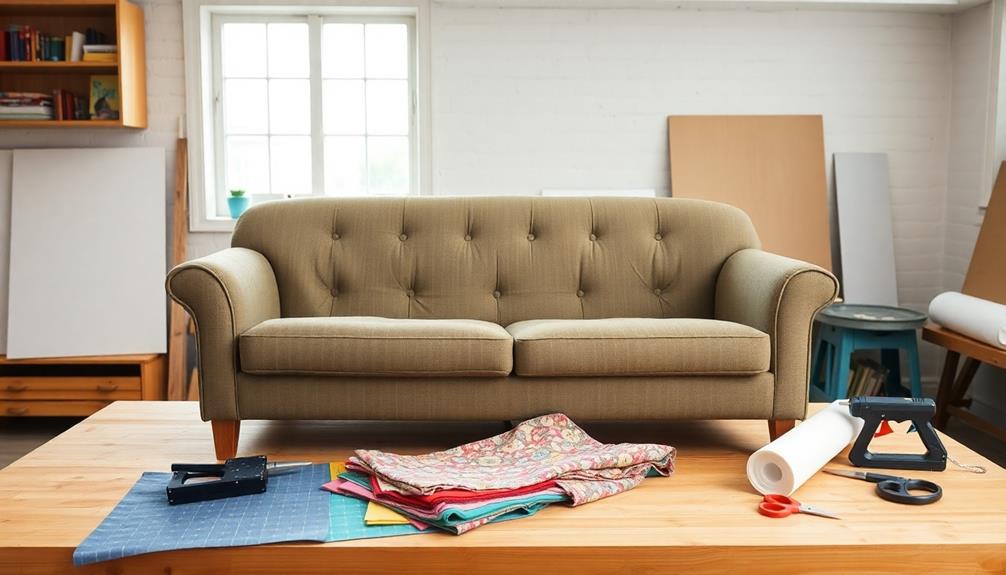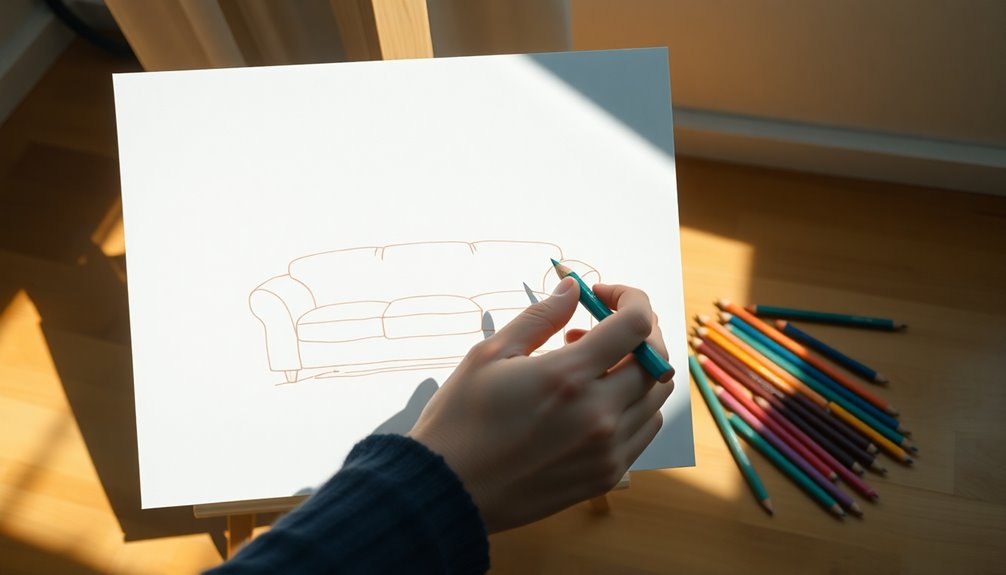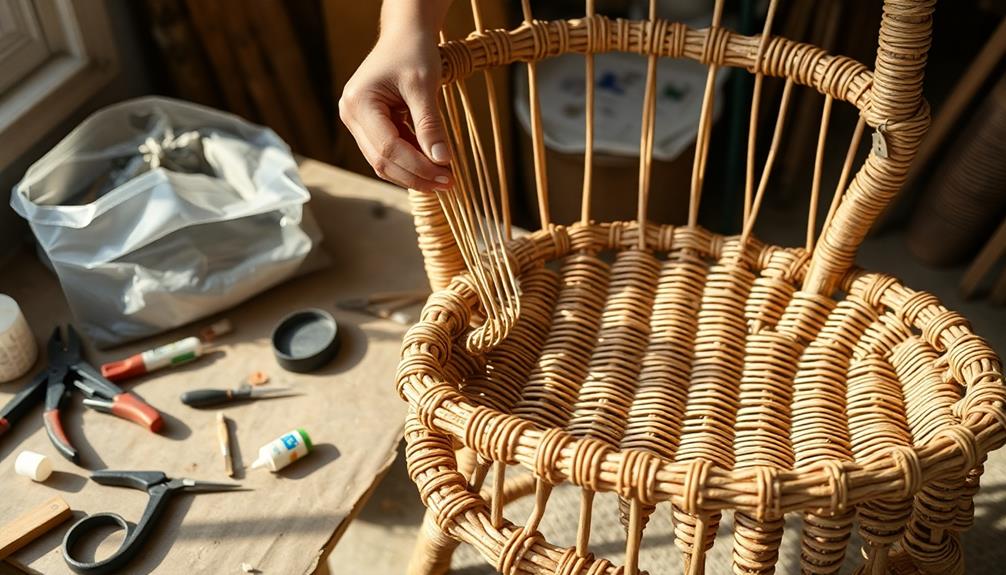To revamp your sofa, begin by assessing its condition, focusing on the frame. Make sure to gather necessary materials such as fabric, a staple gun, and scissors. Remove the old upholstery by flipping the sofa over, removing the legs, and taking out staples. Keep detailed notes for future reference. Cut and measure new fabric, allowing for additional material for seams. Attach the new fabric starting from the center and working outward, securing it tightly with a staple gun. Remember to finish with a dust cover and embellishments. Once completed, you’ll appreciate the rejuvenated appearance. If you’re interested in more in-depth information, there is a wealth of knowledge to explore! If you come across worn or sagging cushions, it’s crucial to examine the springs before adding new fabric. You can significantly enhance both comfort and durability by learning how to fix sofa springs. By tightening or replacing any loose or damaged springs, you can restore the sofa’s integrity, guaranteeing a more solid and supportive seating experience.
Key Takeaways
- Assess the sofa's condition and document any repairs needed before starting the reupholstery process.
- Remove old upholstery carefully, keeping the pieces as patterns for cutting new fabric.
- Select durable upholstery fabric and take accurate measurements, adding extra for seams.
- Apply the new fabric from the center outwards, using a staple gun for secure attachment.
- Finish with a dust cover, ensuring a neat appearance and eliminating any loose staples.
Understanding Reupholstery Basics
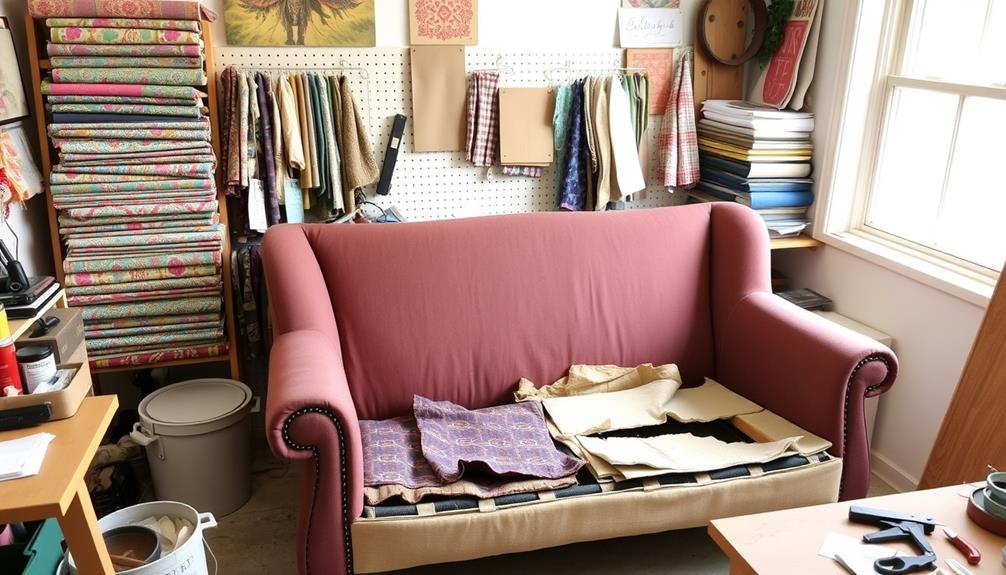
When you're considering reupholstery, it's essential to understand the basics of the process. Reupholstering involves recovering your furniture, like an old sofa, with new fabric while often requiring structural changes. This isn't just about replacing the fabric; it's a thorough approach that can breathe new life into your piece.
Before diving in, you'll want to assess the condition of your furniture. If the frame is undamaged, reupholstering can be a cost-effective way to refresh it, especially if you have a vintage piece that holds sentimental value. Additionally, this process aligns with a commitment to sustainability and efficient resource use, as seen in sustainability practices in modern design.
One of the best parts of reupholstering is the customization it offers—you can choose fabrics that align with your style, enhancing both aesthetics and durability.
However, keep in mind that this process can be labor-intensive and time-consuming, making it more suitable for advanced DIYers or motivated intermediates. Beginners might want to start with smaller projects to build their skills.
Preparing for the Project
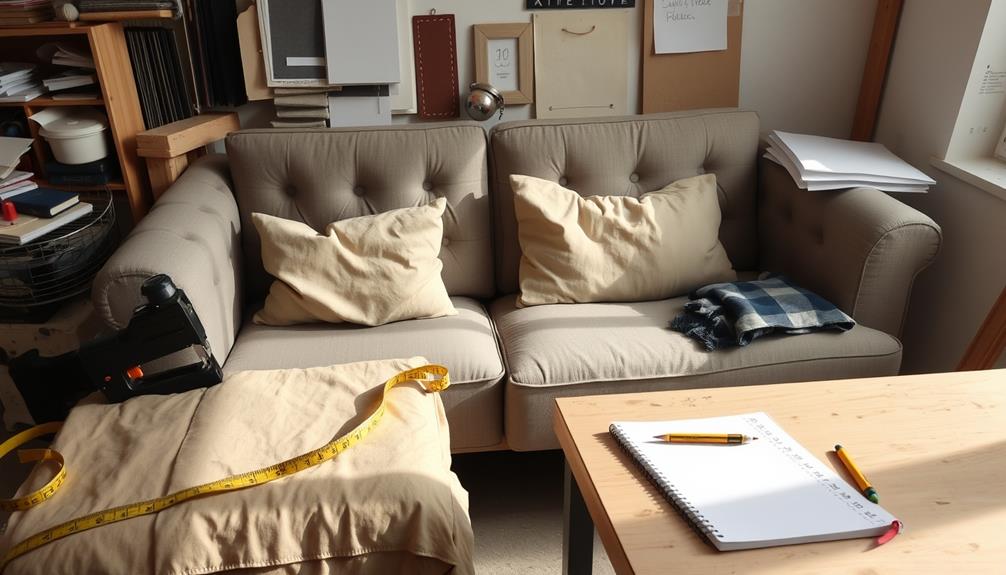
Preparing for your reupholstery project involves a thorough assessment of your sofa's condition. Start by examining your couch for any repairs or structural issues, and document everything that needs attention. This will help you stay organized and guarantee nothing gets overlooked.
Additionally, consider the long-term durability of your upholstery fabric; selecting energy-efficient appliances can be a helpful reference for understanding material resilience.
Next, create an extensive list of supplies you'll need. This should include upholstery fabric, a staple gun, scissors, measuring tape, and safety gear like gloves and goggles. Accurate measurements are vital, so make sure to measure all visible fabric areas carefully. Add an extra 4 inches for seams and hidden sections to confirm you have enough material.
As you prepare, plan for a project duration of about three weekends and some weekday evenings. This timeframe allows ample time for careful dismantling and reassembly, which is essential for a successful outcome.
Don't forget to visit local fabric stores to physically assess materials. Take detailed notes and measurements to guide your fabric selection process.
Removing Old Upholstery
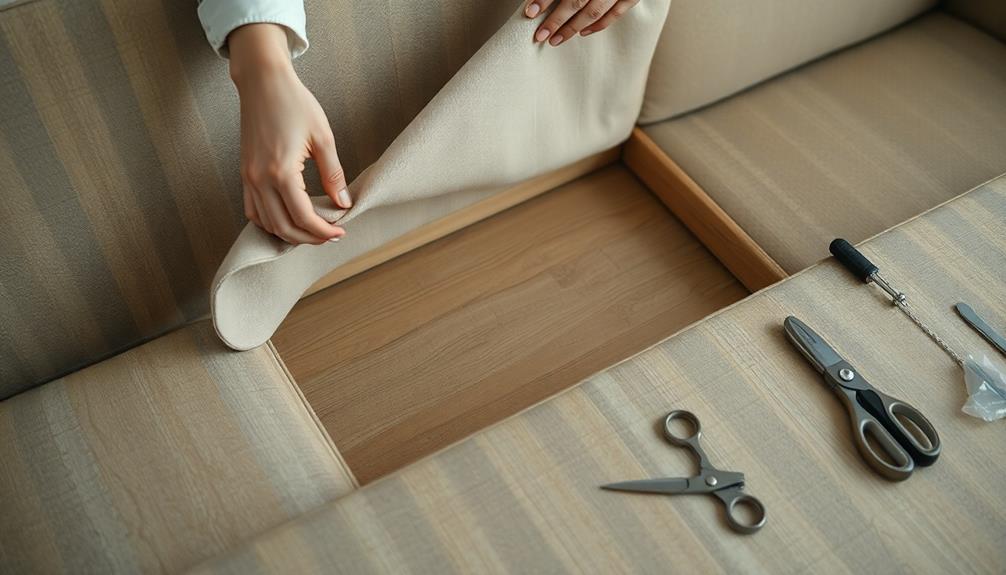
With your sofa ready for a makeover, it's time to tackle the removal of the old upholstery. Begin by flipping the sofa upside-down and detaching the legs and dust cover to access the underlying upholstery. Use a staple remover or pliers to carefully pull out the staples holding the old fabric in place, starting from the bottom and working your way up to avoid damaging the frame.
Consider incorporating natural materials in your new upholstery choice to align with modern farmhouse decor trends.
Remove the upholstery in reverse order of application. Start with the outside back, then the arms, inside back, and deck. As you work, document each piece for reference; this will help you later when you reupholster.
During disassembly, inspect the cushions for any compromised filling materials. You might need to replace or add new foam for better comfort and support.
Keep the old fabric pieces as patterns for cutting new upholstery. This guarantees you maintain accurate measurements and seam allowances for a proper fit.
Applying New Fabric
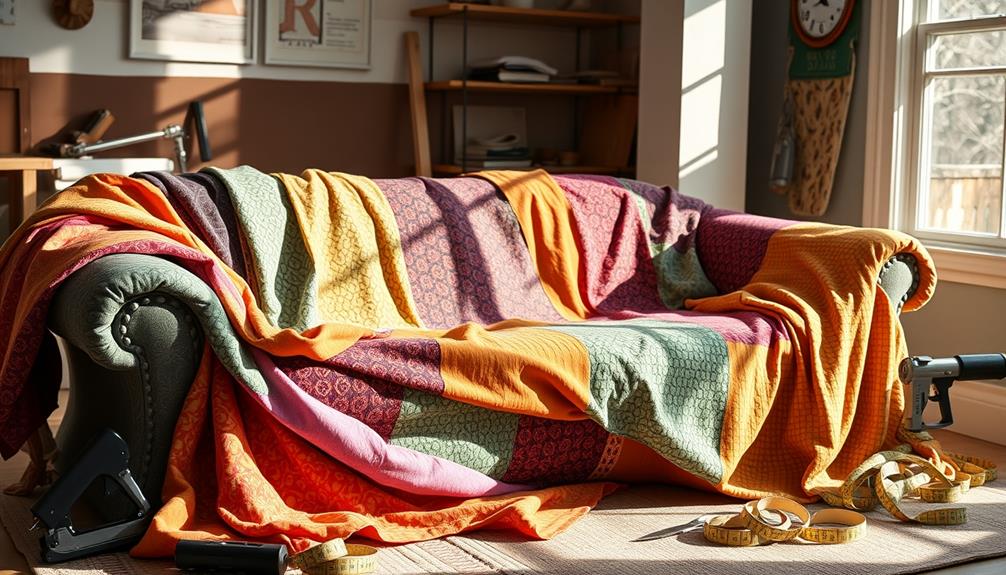
Applying new fabric to your sofa can be an exciting step in your reupholstery project. Start at the center of the sofa and work your way outwards. This technique helps maintain even tension and prevents wrinkles. Grab your heavy-duty staple gun and begin securing the fabric to the frame. Make certain to place each staple close together for a solid hold. Be sure to smooth the fabric as you go, pulling it taut but not overstretching. Once the fabric is fully secured, trim any excess material and inspect for any areas that may need extra staples. After completing the upholstery, you can enhance the look by considering how to arrange throws and cushions for added comfort and style, ensuring they complement your newly upholstered piece.
When you reach the corners, fold the fabric neatly before securing it with staples. This creates a clean and professional appearance that enhances your sofa's look. After attaching the fabric, trim any excess while leaving a small allowance. This prevents fraying and guarantees a tidy finish.
To elevate the aesthetic, consider adding decorative elements like cording or trim along the edges. They provide a polished look that can transform your sofa.
| Step | Description |
|---|---|
| 1. Start at the Center | Begin applying fabric from the center. |
| 2. Secure with Staples | Use a staple gun for a strong hold. |
| 3. Finish with Trim | Add decorative elements for enhancement. |
With these steps, you'll have a beautifully reupholstered sofa ready to enjoy!
Final Touches and Considerations
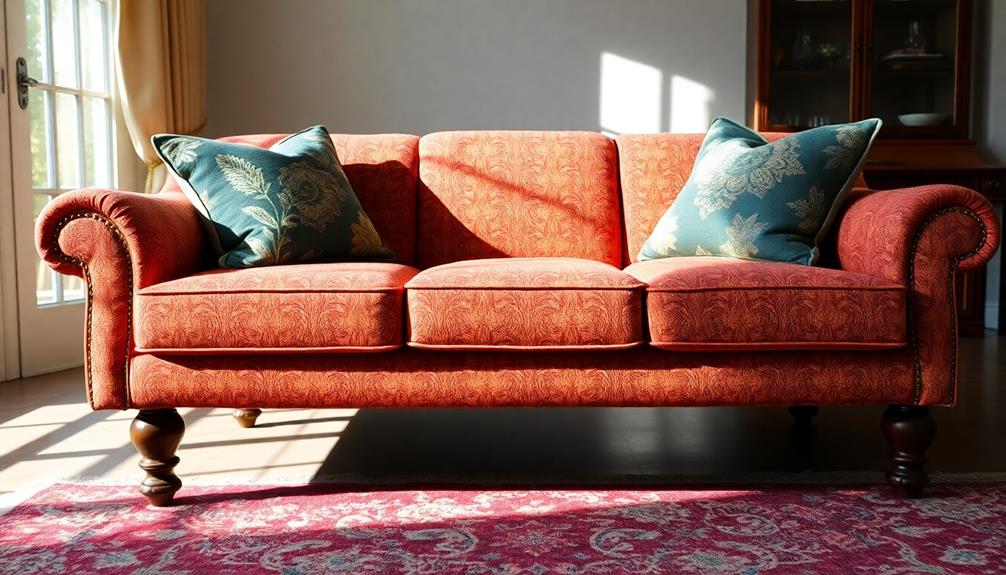
After securing the new fabric, it's time to focus on the final touches that will complete your reupholstery project. Start by attaching a cambric dust cover to the couch base. This not only conceals staples but also provides a neat finish.
Additionally, verifying that your upholstery is free from dust and allergens will help maintain a clean and healthy environment, making it beneficial to explore effective dust removal vacuums.
Next, inspect the sofa thoroughly for any loose staples or uneven fabric, and trim any excess fabric to verify a clean appearance.
To enhance the aesthetic appeal of your newly upholstered sofa, consider adding decorative elements like trim, cording, or buttons. These small details can make a big difference in the overall look.
Once you've finished these adjustments, allow the couch to air out for a few hours. This helps eliminate any odors from adhesives or new fabric.
Remember that regular maintenance is key to keeping your sofa looking fresh. Make a habit of vacuuming frequently to remove dust and debris, and don't forget spot cleaning for any stains.
Frequently Asked Questions
Can You Reupholster a Sofa Yourself?
Yes, you can definitely reupholster a sofa yourself! It's cost-effective, but make sure you've got the skills and tools needed. Start small, measure accurately, and document the original upholstery for the best results.
Is It Worth It to Reupholster a Sofa?
When it comes to reupholstering a sofa, you've got to weigh the pros and cons. If your couch has sentimental value and needs a facelift, it's definitely worth the investment for longevity and customization.
How Difficult Is It to Reupholster a Couch?
Reupholstering a couch can be quite challenging. You'll need patience and some DIY skills. If you're not experienced, you might feel overwhelmed by the intricate steps involved and the precise measurements required.
How Much Should It Cost to Reupholster a Sofa?
You can expect to pay between $600 and $1,200 to reupholster your sofa. Factors like fabric choice and labor costs profoundly affect the price, so consider these when budgeting for your project.
Conclusion
Reupholstering your sofa might seem intimidating, but it's more rewarding than you think. You're not just giving your furniture a facelift; you're creating a piece that reflects your style and stands the test of time. Don't worry about making mistakes—every flaw tells a story and adds character. Plus, you'll save money while reducing waste. So roll up your sleeves and jump in; the satisfaction of transforming your sofa is worth every effort you put in!
